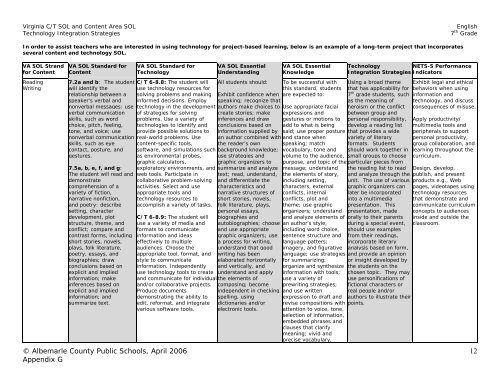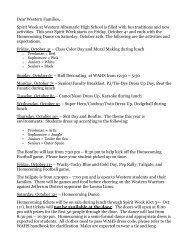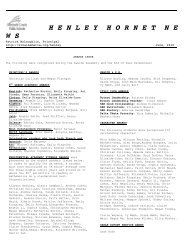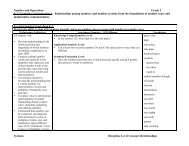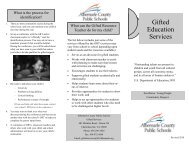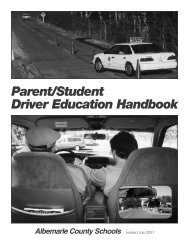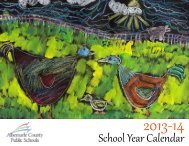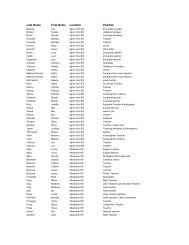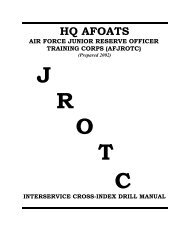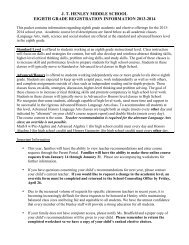Language Arts/English Curriculum Frameworks - Albemarle County ...
Language Arts/English Curriculum Frameworks - Albemarle County ...
Language Arts/English Curriculum Frameworks - Albemarle County ...
Create successful ePaper yourself
Turn your PDF publications into a flip-book with our unique Google optimized e-Paper software.
Virginia C/T SOL and Content Area SOL <strong>English</strong><br />
Technology Integration Strategies 7 th Grade<br />
In order to assist teachers who are interested in using technology for project-based learning, below is an example of a long-term project that incorporates<br />
several content and technology SOL.<br />
VA SOL Strand<br />
for Content<br />
Reading<br />
Writing<br />
VA SOL Standard for<br />
Content<br />
7.2a and b: The student<br />
will identify the<br />
relationship between a<br />
speaker’s verbal and<br />
nonverbal messages: use<br />
verbal communication<br />
skills, such as word<br />
choice, pitch, feeling,<br />
tone, and voice; use<br />
nonverbal communication<br />
skills, such as eye<br />
contact, posture, and<br />
gestures.<br />
7.5a, b, e, f, and g:<br />
The student will read and<br />
demonstrate<br />
comprehension of a<br />
variety of fiction,<br />
narrative nonfiction,<br />
and poetry: describe<br />
setting, character<br />
development, plot<br />
structure, theme, and<br />
conflict; compare and<br />
contrast forms, including<br />
short stories, novels,<br />
plays, folk literature,<br />
poetry, essays, and<br />
biographies; draw<br />
conclusions based on<br />
explicit and implied<br />
information; make<br />
inferences based on<br />
explicit and implied<br />
information; and<br />
summarize text.<br />
VA SOL Standard for<br />
Technology<br />
C/T 6-8.8: The student will<br />
use technology resources for<br />
solving problems and making<br />
informed decisions. Employ<br />
technology in the development<br />
of strategies for solving<br />
problems. Use a variety of<br />
technologies to identify and<br />
provide possible solutions to<br />
real-world problems. Use<br />
content-specific tools,<br />
software, and simulations such<br />
as environmental probes,<br />
graphic calculators,<br />
exploratory environments, and<br />
web tools. Participate in<br />
collaborative problem-solving<br />
activities. Select and use<br />
appropriate tools and<br />
technology resources to<br />
accomplish a variety of tasks.<br />
C/T 6-8.9: The student will<br />
use a variety of media and<br />
formats to communicate<br />
information and ideas<br />
effectively to multiple<br />
audiences. Choose the<br />
appropriate tool, format, and<br />
style to communicate<br />
information. Independently<br />
use technology tools to create<br />
and communicate for individual<br />
and/or collaborative projects.<br />
Produce documents<br />
demonstrating the ability to<br />
edit, reformat, and integrate<br />
various software tools.<br />
© <strong>Albemarle</strong> <strong>County</strong> Public Schools, April 2006<br />
Appendix G<br />
VA SOL Essential<br />
Understanding<br />
All students should:<br />
Exhibit confidence when<br />
speaking; recognize that<br />
authors make choices to<br />
create stories; make<br />
inferences and draw<br />
conclusions based on<br />
information supplied by<br />
an author combined with<br />
the reader’s own<br />
background knowledge;<br />
use strategies and<br />
graphic organizers to<br />
summarize and analyze<br />
text; read, understand,<br />
and differentiate the<br />
characteristics and<br />
narrative structures of<br />
short stories, novels,<br />
folk literature, plays,<br />
personal essays,<br />
biographies and<br />
autobiographies; choose<br />
and use appropriate<br />
graphic organizers; use<br />
a process for writing,<br />
understand that good<br />
writing has been<br />
elaborated horizontally<br />
and vertically, and<br />
understand and apply<br />
the elements of<br />
composing; become<br />
independent in checking<br />
spelling, using<br />
dictionaries and/or<br />
electronic tools.<br />
VA SOL Essential<br />
Knowledge<br />
To be successful with<br />
this standard, students<br />
are expected to:<br />
Use appropriate facial<br />
expressions and<br />
gestures or motions to<br />
add to what is being<br />
said; use proper posture<br />
and stance when<br />
speaking; match<br />
vocabulary, tone and<br />
volume to the audience,<br />
purpose, and topic of the<br />
message; understand<br />
the elements of story,<br />
including setting,<br />
characters, external<br />
conflicts, internal<br />
conflicts, plot and<br />
theme; use graphic<br />
organizers; understand<br />
and analyze elements of<br />
an author’s style,<br />
including word choice,<br />
sentence structure and<br />
language patters;<br />
imagery, and figurative<br />
language; use strategies<br />
for summarizing;<br />
organize and synthesize<br />
information with tools;<br />
use a variety of<br />
prewriting strategies;<br />
and use written<br />
expression to draft and<br />
revise compositions with<br />
attention to voice, tone,<br />
selection of information,<br />
embedded phrases and<br />
clauses that clarify<br />
meaning; vivid and<br />
precise vocabulary,<br />
Technology<br />
NETS-S Performance<br />
Integration Strategies Indicators<br />
Using a broad theme<br />
that has applicability for<br />
7 th grade students, such<br />
as the meaning of<br />
heroism or the conflict<br />
between group and<br />
personal responsibility,<br />
develop a reading list<br />
that provides a wide<br />
variety of literary<br />
formats. Students<br />
should work together in<br />
small groups to choose<br />
particular pieces from<br />
the reading list to read<br />
and analyze through the<br />
unit. The use of various<br />
graphic organizers can<br />
later be incorporated<br />
into a multimedia<br />
presentation. This<br />
presentation, made<br />
orally to their parents<br />
during a special event,<br />
should use examples<br />
from their readings,<br />
incorporate literary<br />
analysis based on form,<br />
and provide an opinion<br />
or insight developed by<br />
the students on the<br />
chosen topic. They may<br />
use personifications of<br />
fictional characters or<br />
real people and/or<br />
authors to illustrate their<br />
points.<br />
Exhibit legal and ethical<br />
behaviors when using<br />
information and<br />
technology, and discuss<br />
consequences of misuse.<br />
Apply productivity/<br />
multimedia tools and<br />
peripherals to support<br />
personal productivity,<br />
group collaboration, and<br />
learning throughout the<br />
curriculum.<br />
Design, develop,<br />
publish, and present<br />
products e.g., Web<br />
pages, videotapes using<br />
technology resources<br />
that demonstrate and<br />
communicate curriculum<br />
concepts to audiences<br />
inside and outside the<br />
classroom.<br />
12


